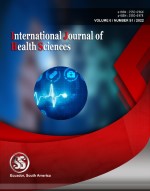Comparison between effect of reflexology and Maitland mobilization in treatment of frozen shoulder of diabetic patients type II
Keywords:
adhesive capsulitis, ROM, diabetes type II, reflexology, maitland mobilizationAbstract
Diabetes metabolic disorders can lead to changes in connective tissue and adhesive capsulitis (AC) is one of the most common complications that occour with diabetes where it is defined as pain restriction in the glenohumeral joint capsule that causes limitation in ROM of shoulder. Physiotherapy has many modalities that proved their role in improving symptoms of AC and so this study was aiming to Know which is more effective in improving symptoms: ROM (flexion, abduction, external rotation, internal rotation) and Shoulder pain , Reflexology, or Maitland mobilization in treatment of type II diabetic patients.Thirty patients from both genders with age ranged from 50-60 years were recruited for this study. They were divided randomly into two groups of equal number (Group A – Maitland mobilization) and (Group B – Reflexology). Data obtained from both groups before and after 8 successive weeks of intervention was statistically treated to analyze the scores of visual analogue scale (score), shoulder flexion ROM (angle), shoulder abduction ROM (angle), shoulder internal rotation ROM (angle) and shoulder external rotation ROM (angle) to determine which is more e.
Downloads
References
Thong, E.P., Codner, E., Laven, J.S. and Teede, H., (2020): Diabetes: a metabolic and reproductive disorder in women. The Lancet Diabetes & Endocrinology, Vol.8(2), pp.134-149.
Lluch-Girbés, E., Dueñas, L., Mena-del Horno, S., Luque-Suarez, A., Navarro-Ledesma, S. and Louw, A., (2019). A central nervous system-focused treatment approach for people with frozen shoulder: protocol for a randomized clinical trial. Trials, Vol.20(1), pp.1-10.
Hengeveld, E. and K. Banks.,(2013). Maitland's Vertebral Manipulation E-Book: Management of Neuromusculoskeletal Disorders, Elsevier Health Sciences,Vol. 1.
Kliegel, E. (2018). Holistic Reflexology: Essential Oils and Crystal Massage in Reflex Zone Therapy, Simon and Schuster.
John B., D. J.,Wexler, A.T. , P.R., G.M., C.M., David., D’Alessio & M.J.D.,(2018):Management of hyperglycaemia in type 2 diabetes. A consensus report by the American Diabetes Association (ADA) and the European Association for the Study of Diabetes (EASD). Diabetologia Vol.61(12): 2461-2498.
Sathe, S., Khurana, S.K., Damke, U. and Agrawal, P.V., (2020):To Compare the Effects of Maitland Mobilization with Conventional Physiotherapy in Adhesive Capsulitis. Int J Cur Res Rev| Vol, 12(14).
Kerautret, Y.,F.D.R.,Carole & A.G., (2020). Selective effects of manual massage and foam rolling on perceived recovery and performance: current knowledge and future directions toward robotic massages. Frontiers in physiology.,vol.11(1) ,p.1567.
Published
How to Cite
Issue
Section
Copyright (c) 2022 International journal of health sciences

This work is licensed under a Creative Commons Attribution-NonCommercial-NoDerivatives 4.0 International License.
Articles published in the International Journal of Health Sciences (IJHS) are available under Creative Commons Attribution Non-Commercial No Derivatives Licence (CC BY-NC-ND 4.0). Authors retain copyright in their work and grant IJHS right of first publication under CC BY-NC-ND 4.0. Users have the right to read, download, copy, distribute, print, search, or link to the full texts of articles in this journal, and to use them for any other lawful purpose.
Articles published in IJHS can be copied, communicated and shared in their published form for non-commercial purposes provided full attribution is given to the author and the journal. Authors are able to enter into separate, additional contractual arrangements for the non-exclusive distribution of the journal's published version of the work (e.g., post it to an institutional repository or publish it in a book), with an acknowledgment of its initial publication in this journal.
This copyright notice applies to articles published in IJHS volumes 4 onwards. Please read about the copyright notices for previous volumes under Journal History.
















